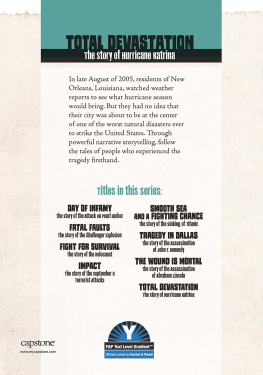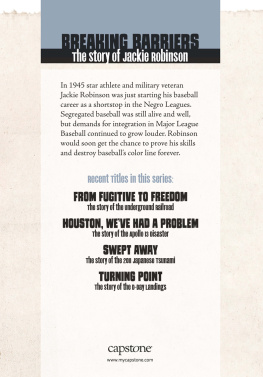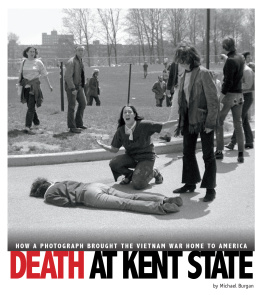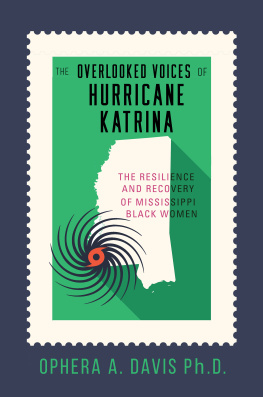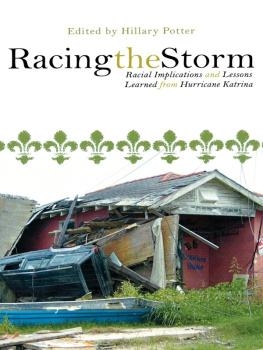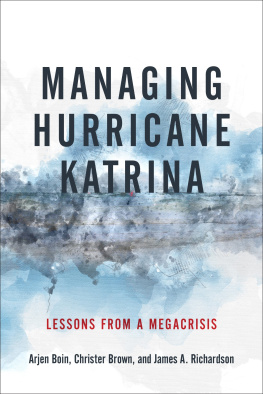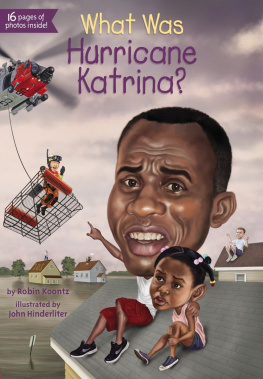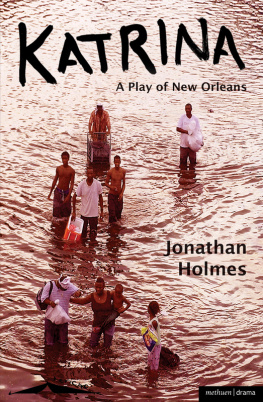Michael Burgan - Total Devastation: The Story of Hurricane Katrina
Here you can read online Michael Burgan - Total Devastation: The Story of Hurricane Katrina full text of the book (entire story) in english for free. Download pdf and epub, get meaning, cover and reviews about this ebook. year: 2016, publisher: Capstone, genre: Art. Description of the work, (preface) as well as reviews are available. Best literature library LitArk.com created for fans of good reading and offers a wide selection of genres:
Romance novel
Science fiction
Adventure
Detective
Science
History
Home and family
Prose
Art
Politics
Computer
Non-fiction
Religion
Business
Children
Humor
Choose a favorite category and find really read worthwhile books. Enjoy immersion in the world of imagination, feel the emotions of the characters or learn something new for yourself, make an fascinating discovery.
- Book:Total Devastation: The Story of Hurricane Katrina
- Author:
- Publisher:Capstone
- Genre:
- Year:2016
- Rating:3 / 5
- Favourites:Add to favourites
- Your mark:
- 60
- 1
- 2
- 3
- 4
- 5
Total Devastation: The Story of Hurricane Katrina: summary, description and annotation
We offer to read an annotation, description, summary or preface (depends on what the author of the book "Total Devastation: The Story of Hurricane Katrina" wrote himself). If you haven't found the necessary information about the book — write in the comments, we will try to find it.
In an immersive, exciting narrative nonfiction format, this powerful book follows a selection of people who experienced the events of Hurricane Katrina.
Total Devastation: The Story of Hurricane Katrina — read online for free the complete book (whole text) full work
Below is the text of the book, divided by pages. System saving the place of the last page read, allows you to conveniently read the book "Total Devastation: The Story of Hurricane Katrina" online for free, without having to search again every time where you left off. Put a bookmark, and you can go to the page where you finished reading at any time.
Font size:
Interval:
Bookmark:

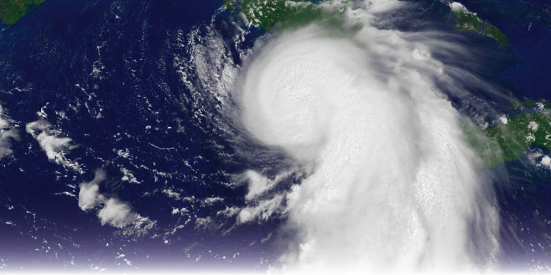
On August 26, 2005, residents of New Orleans, Louisiana, kept an eye on weather reportsas they wondered if an approaching hurricane would hit their city and affect theirlives. Along with other people in the Gulf of Mexico and Atlantic regions, they wereseveral months into hurricane season. So far tropical storms as well as several hurricaneshad already come and gone. In July, two hurricanes, Dennis and Emily, had blown through.These storms had taken lives and caused damage in surrounding areas, but so far NewOrleansand most of the United Stateshad been spared.
Local, state, and federal officials also watched the weather reports. They had theresponsibility of deciding if a storm was severe enough that people should leave their homes and seek safety away from the coast.
At the National Hurricane Center in Miami, Florida, stared intentlyat their computer screens, looking at satellite images and data. On a wall next tothem, a large map showed the United States with the Atlantic and Pacific Oceans oneither side. Off the west coast of the southern end of Florida was a red marker thatstood for Hurricane Katrina. It had just crossed into the Gulf of Mexico from Floridaas a Category 1 storm. That meant Katrina was the least powerful kind of hurricane,with wind speeds between 74 and 95 miles per hour. The most powerful hurricane, aCategory 5, would have sustained winds of more than 156 miles per hourstrong enoughto destroy homes and uproot most trees in its path.
The meteorologists analyzed data on the storm and kept watching their computers.There was no way to be sure which direction Katrina would go or how powerful it wouldbecome.
A week after Katrina hit New Orleans, Warren Riley stood in front of reporters andsaid, We advise people that this city has been destroyed. Almost all the peoplewho had stayed in New Orleans during the storm had now left the f looded city. Rileyencouraged the few thousand who remained to seek dry land. He said that citizenswith boats who wanted to help with rescue efforts were welcome, but asked that theywork with the city rather than on their own.
Riley also addressed the question of why more police hadnt been available to helpin the days after Katrina. He explained that 400 to 500 officers were not accountedfor. Some left for various reasons. Some of those officers, Riley said, lost theirhomes; they dont know where their families are; where their spouses are, and theyreout looking for them; some left because they simply could not deal with this catastrophe.Riley added, This was probably the greatest catastrophe in an American city.
The final numbers on Katrina highlight the size of that catastrophe. In all, morethan 1,800 people died because of the storm, and it caused more than $135 billionin damages. Some of the dead were never identified and family members never claimedtheir bodies. The year after the storm, the population of New Orleans and the surroundingarea had fallen by more than 200,000. Many people who had fled Katrina never returned.By 2014, though, the areas population had risen, though it still did not reach thenumber who lived there before Katrina.
In Washington, D.C., lawmakers in Congress wanted to know what the National HurricaneCenter had done in the days before Katrina. They wanted to know what meteorologistscould do in the future to provide better forecasts. Max Mayfield did not speak directlyto Congress, but he sent a written statement that was dated September 20, 2005.
In his statement, Mayfield described how accurately he and his staff predicted Katrinaspath in the Gulf of Mexico. He outlined the warnings the center gave. He also discussedthe possibility of other deadly storms. He wrote, Katrina will not be the last majorhurricane to hit a area, and New Orleans is not the only location vulnerableto a large disaster from a land-falling hurricane. Houston/Galveston, Tampa Bay,southwest Florida, Florida Keys, southeast Florida, New York City/Long Island, andbelieve it or not, New England, are all especially vulnerable. And New Orleans remainsvulnerable to future hurricanes.
A month later, Marty Bahamonde spoke to members of the U.S. Senate. They wanted toknow what FEMA had done before and during Katrina. Bahamonde described his actionsfrom when he arrived in New Orleans until he left. He said, From this [hearing]I hope that we are able to effect change so that no other child, no other seniorcitizen, no other special needs patient, no other parent, and no other communityin this country will ever have to experience the horrors and tragedy that happenedin New Orleans and the entire Gulf Coast that week.
In 2015, the people of New Orleans marked the tenth anniversary of Katrina in differentways. Some went to memorial services to honor the dead. Others took part in volunteeractivities across the city. A parade went through one part of the city that had beenbadly damaged, to show the recovery efforts still going on. The U.S. government hadhelped the citys recovery by spending billions of dollars to build new floodgatesand pumps in New Orleans. Other projects continue to build new flood control systemsand fortifications to protect southern Louisiana from future hurricanes.
Just before the tenth anniversary, President Barack Obama visited New Orleans. OnAugust 29, he tweeted this message from the citys Trem neighborhood: In Trem,I was inspired by the progress & people 10 years after Katrina. It gives us hope,but our work isnt done.
- AUGUST 23, 2005: The National Hurricane Center issues its first advisory about thetropical weather system that will become Hurricane Katrina.
- AUGUST 24: The weather system strengthens and is named tropical storm Katrina.
- AUGUST 25: Katrina continues to strengthen and is upgraded to a Category 1 hurricane.
- AUGUST 26: Hurricane Katrina enters the Gulf of Mexico and gains strength as it headstoward New Orleans; states of emergency are declared in Louisiana and Mississippi.
- AUGUST 27: Louisiana governor Kathleen Blanco tells residents in low-lying areasnear the Gulf Coast to evacuate, but the order is not mandatory.
- AUGUST 28: Max Mayfield of the National Hurricane Center informs the Federal EmergencyManagement Agency that Katrina is now a Category 5 storm and is on track to hit NewOrleans; the citys mayor, Ray Nagin, orders a mandatory evacuation but many residentsremain in New Orleans; the Superdome opens for people who want to leave their homesbut cant leave the city.
- AUGUST 29: Katrina makes landfall around 6:00 a.m., with winds reaching 145 milesper hour; later in the morning, the first of several levees breaches, filling partsof New Orleans with water; residents continue to flock to the Superdome, which lostpower during the storm, while others now go to the Morial Convention Center; lootersbegin to rob whatever they can take from closed stores.
- AUGUST 30: Some hospitals begin evacuating patients as floodwater continues to risein parts of the city; people with boats try to rescue people trapped in their homes.
- AUGUST 31: For the first time, the media reports on the horrible conditions at theconvention center; volunteers from outside New Orleans come to rescue stranded people.
- SEPTEMBER 1: The first buses arrive to take people out of the Superdome; PresidentGeorge W. Bush condemns the crime that has occurred in New Orleans.
Font size:
Interval:
Bookmark:
Similar books «Total Devastation: The Story of Hurricane Katrina»
Look at similar books to Total Devastation: The Story of Hurricane Katrina. We have selected literature similar in name and meaning in the hope of providing readers with more options to find new, interesting, not yet read works.
Discussion, reviews of the book Total Devastation: The Story of Hurricane Katrina and just readers' own opinions. Leave your comments, write what you think about the work, its meaning or the main characters. Specify what exactly you liked and what you didn't like, and why you think so.

